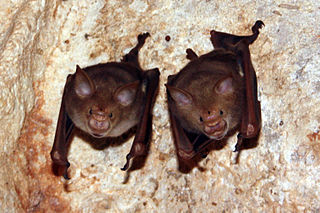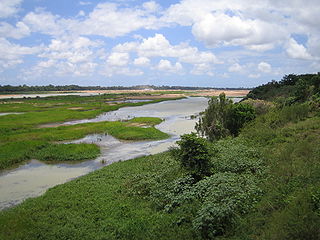
Obdurodon is a genus of extinct monotreme. They appeared much like their modern day relative the platypus, except adults retained their molar teeth. Unlike the platypus which forages on the lakebed, Obdurodon may have foraged in the water column or surface.

The order Peramelemorphia includes the bandicoots and bilbies; it equates approximately to the mainstream of marsupial omnivores. All members of the order are endemic to the twin land masses of Australia-New Guinea and most have the characteristic bandicoot shape: a plump, arch-backed body with a long, delicately tapering snout, very large upright ears, relatively long, thin legs, and a thin tail. Their size varies from about 140 grams up to 4 kilograms, but most species are about one kilogram, or the weight of a half-grown kitten.

Riversleigh World Heritage Area is Australia's most famous fossil location, recognised for the series of well preserved fossils deposited from the Late Oligocene to more recent geological periods. The fossiliferous limestone system is located near the Gregory River in the north-west of Queensland, an environment that was once a very wet rainforest that became more arid as the Gondwanan land masses separated and the Australian continent moved north. The approximately 100 square kilometres (39 sq mi) area has fossil remains of ancient mammals, birds, and reptiles of the Oligocene and Miocene ages, many of which were discovered and are only known from the Riversleigh area; the species that have occurred there are known as the Riversleigh fauna.

Hipposideros is one of the most diverse genera of bats, with more than 70 species. They are collectively called roundleaf bats after the shape of their nasal ornament. It is the type genus of the family Hipposideridae. It is divided into species groups based on morphology.

The fawn leaf-nosed bat – Hipposideros cervinus – is a species of bat in the family Hipposideridae found in Australia, Indonesia, Malaysia, the Philippines and Vanuatu.

The Hipposideridae are a family of bats commonly known as the Old World leaf-nosed bats. While it has often been seen as a subfamily, Hipposiderinae, of the family Rhinolophidae, it is now more generally classified as its own family. Nevertheless, it is most closely related to Rhinolophidae within the suborder Yinpterochiroptera.
Brachipposideros is an extinct genus of leaf-nosed bats known from Riversleigh, north-western Queensland, Australia and the Languedoc-Roussillon Region, France. The fossils date to the late Oligocene to early Miocene.
Australonycteris is an extinct and monotypic genus of microchiropteran bat with the single species Australonycteris clarkae. The species is known from fragmentary remains found at the Murgon fossil site, in south-eastern Queensland, dating to the early Eocene, 54.6 million years ago. It is the oldest bat from the Southern Hemisphere and one of the oldest bats in the world, and inhabited forests and swampy areas, with a diet of insects and possibly small fish.
Naraboryctes philcreaseri is a fossil species of marsupial found at early Miocene deposits of Boodjamulla National Park of Riversleigh area, northwestern Queensland, Australia.

The Bluff Downs fossil site is a paleontological site of Pliocene age in northern Queensland, Australia. It is one of the most significant fossil sites of Pliocene age in Australia due to its unique fauna and specific dating. The fossil site lies on the banks of the Allingham Creek on the pastoral property of Bluff Downs Station, northwest of Charters Towers on the Cape York Peninsula
Malleodectes is a genus of unusual marsupial species, first discovered in 2011 at Riversleigh, Queensland, Australia. It could grow as large as a ferret, and lived in the Miocene, 17 million years ago. The reason for its name, which means "Hammer Biter", is because it has blunt, hammer like teeth, not known from any other mammal extant or extinct. However, Scott Hocknull from the Queensland Museum has noticed similarities to the modern pink-tongued skink, a reptile specialised for eating snails. This suggests that Malleodectes too was a specialised snail hunter.
Rhinonicteris tedfordi is an extinct species of microbat, of the order Chiroptera, known from fossil material found in Australia.
Riversleigh fauna is the collective term for any species of animal identified in fossil sites located in the Riversleigh World Heritage Area.
Xenorhinos halli is a species of bat that existed in the early Miocene. It was discovered at a fossil deposit of the Riversleigh World Heritage Area in the north of Australia.
Riversleigha williamsi is a species of hipposiderid bat discovered in fossil deposits located the Riversleigh World Heritage Area in the north of Australia.
Hipposideros bernardsigei is a hipposiderid species of bat known by fossil specimens, one of the many new taxa of microchiropterans discovered in the Riversleigh World Heritage Area.
Macroderma godthelpi is a species of bat known from fossil material found in Australia, one of the larger carnivorous megadermatid family of the order Chiroptera. They resembled the modern species Macroderma gigas, known as a false vampire or ghost bat, although significantly smaller than any other species of Macroderma.
Pseudomys vandycki is a species of the murid family, mice and rats, that is known from fossils discovered in Queensland, Australia.

Crash bandicoot is an extinct bandicoot, known from fossils located at the Riversleigh World Heritage Area in northeast Australia.
Liyamayi dayi is a mammal species of the Thylacomyidae family known from fossils located at the Riversleigh World Heritage Area in northeast Australia. The discovery of the specimens was identified as deposited around fifteen million years ago, revising the earliest record of this peramelemorphian lineage from those of species that existed around ten million years later.







